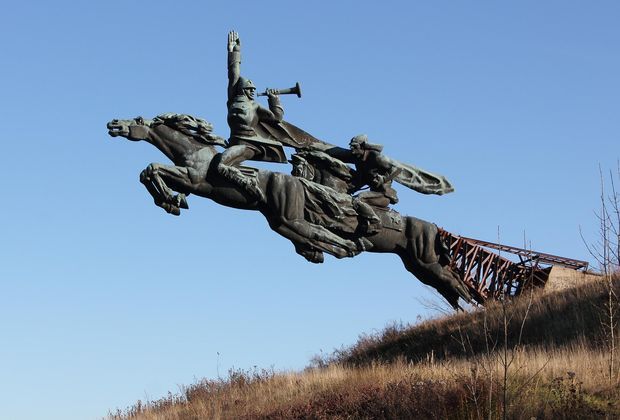Abandoned horses

A horse prancing over the Danube’s waters is an unexpected sight. When one goes down the river on a fast motorboat, the horse looks like it is jumping out of the cane-covered shallows off the Yermakov Island. The man who erected this romantic primitivist sculpture here was planning to open a stud farm on this plot of reserve land, isolated from civilization. However, the plan failed, either due to the lack of money, or because the river swallowed the pastures after the protective dam had been demolished. The pedestal with the Danube stallion and the modern stables have remained out of sight of business, sports and tourism communities ever since. The only response comes from visitors who sail past the structure, depicting it with commonplace phrases of the teenager slang, such as “cool” and “hardcore.”
Horses from another sculpture, erected in 1975 and featuring Red cavalrymen riding them, strive for the sky in the village of Khvativ, Lviv region, far from the warm valley of the Danube. The only thing which these sculptures from different eras, styles, and environments have in common is a strong feeling of abandonment and hopelessness. Both stand shadowed by the goddess of decay’s wings. In a few years, the Danube will swallow the rare breed stallion’s statue, and sturdy walls of the stables will crumble. Someone will feel sorry for the money spent wastefully, someone else will have to clean the reserve of debris. The object has no artistic value.
Sooner or later, forged brass shell will chip off the frame of the Khvativ monument, cast by Valentyn Borysenko, a prominent Ukrainian sculptor. He was the one to carve the statue of the first East Slavic printer Ivan Fyodorov and create the stone sculpture of Ivan Franko, and both works are now popular attractions of Lviv. With the looming death of his equestrian sculpture in Khvativ, a significant piece of Ukrainian culture will vanish...
In any other European country, the fate of the copper stallions and cavalrymen would be different. The stables would have become a motel or a riverbank cafe, while the mound opposite the famous castle of Olesko would be turned into a museum showing riders of all times. Beautiful and expensive structures should never disappear.
However, we, the modern Ukrainians, do not know the “Save As” command, to use the computer jargon. We do not transform our historic heritage to enable it to serve today’s needs, as other nations with a rich and controversial history do. We throw millions into the deep waters with ease and surrender unique creations of our architects to the forces of decay. We see no problem with letting a cre&ation of some rich person to go away, and do not care in the least for monuments of the totalitarian regime – only to lament our poor artistic endowment later on, while living in the cities and villages deprived of sights having even limited artistic value. Poverty has always accompanied squanderers who play dangerous games, such as horse races, with their heritage.






